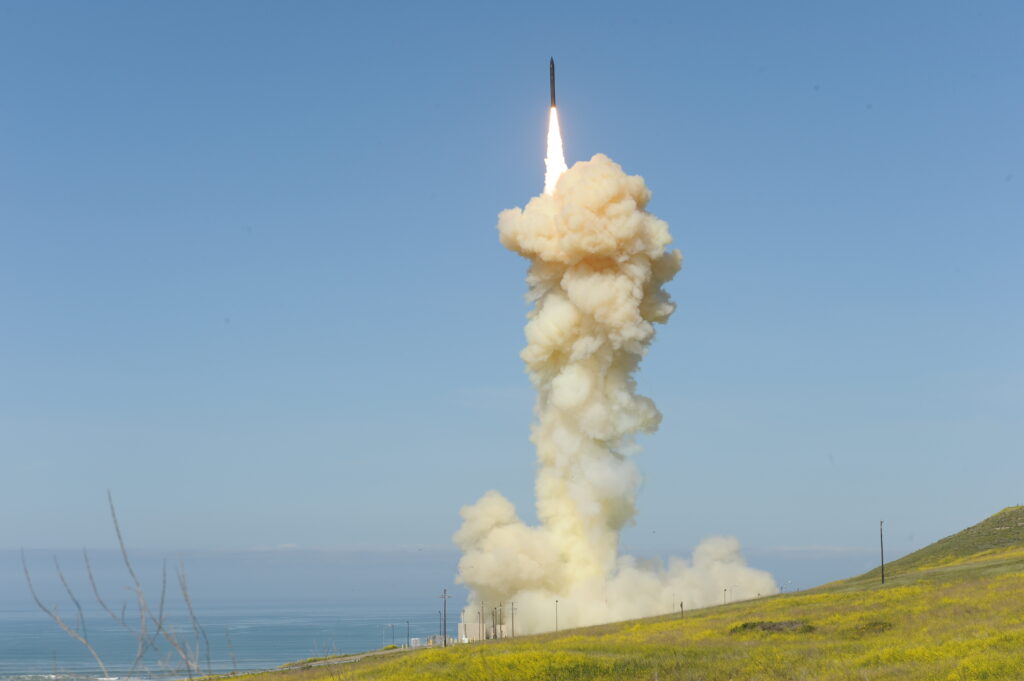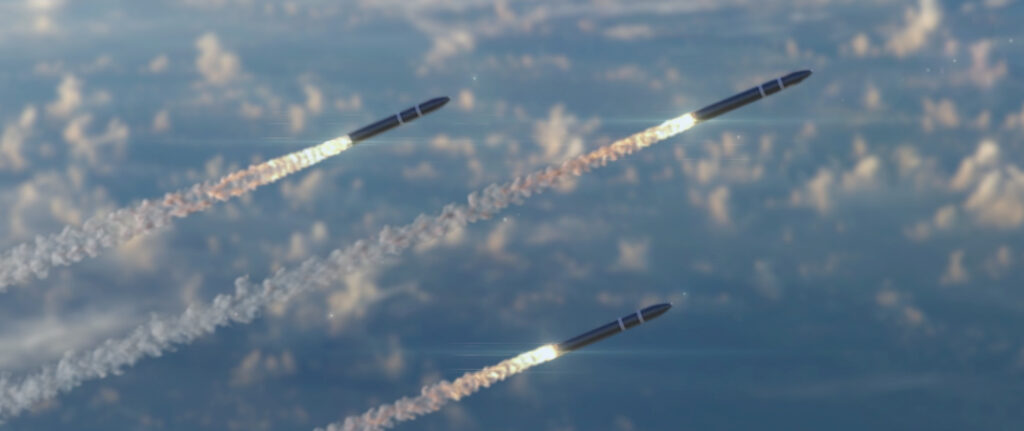The United States Missile Defense Agency (MDA) is developing a Next Generation Interceptor (NGI) to support homeland defence from ballistic missiles. The first units could be fielded in 2027 or 2028.

Credit: MDA
The United States began fielding a Ground-based Missile Defense (GMD) system in 2004. It was never feasible or intended to protect North America from a large scale ballistic missile attack from either Russia or China. The impetus for the GMD system lay in the Intermediate Range Ballistic Missile (IRBM), Inter-Continental Ballistic missile (ICBM), and Weapons of Mass Destruction (WMD) programmes of so-called rogue states, especially North Korea and Iran.
The GMD system is designed to intercept a limited number of incoming ballistic warheads in space during their midcourse flight phase. Circa 44 Ground Based Interceptor (GBI) missiles are currently deployed via in-ground missile silos at Fort Greely in Alaska and Vandenberg Air Force Base in California (the precise number became classified in January 2023, with 44 being the last acknowledged figure). The intercept mission is supported through a network of sea-, ground- and space-based sensors as well as command and control systems.
The GBI is composed of a three-stage solid-fuel booster rocket carrying a single Exoatmospheric Kill Vehicle (EKV). Following separation from the booster, the EKV uses guidance data transmitted from ground support and fire control systems as well as its own on-board sensors to identify the target. The EKV closes with the target using on-board thrusters, and destroys the target through kinetic impact – this defeat mechanism is known as ‘hit-to-kill’.
A Service Life Extension Programme (SLEP) is currently underway to guarantee the viability of the current GBI arsenal past 2030. Eleven of the currently deployed missiles are being equipped with upgraded boosters, electronics and kill vehicles. The SLEP is expected to be completed in early Fiscal Year (FY) 2025. In addition to these upgrades, the MDA has acquired sixteen additional GBIs – over and above the original 44 – since 2017. One more will be delivered by late 2023. These will serve multiple purposes, including additional flight tests of the interceptor system, and replacement for inoperable missiles.

Credit: MDA
Next Generation Interceptor
The current GBI arsenal has several limitations. The flight test record is chequered. Since 1999 the system has failed nine of 20 intercept tests. The current concept of operations is thought to call for launching between two and four missiles per incoming ICBM in order to increase the odds of a successful intercept. In the long run, the reliability issue is overshadowed by the fact that the GBI is not designed to deal with multiple reentry vehicles (MRV), decoy warheads, manoeuvrable payloads or electronic countermeasures to thwart intercept systems. Michelle Atkinson, MDA Director for Operations, confirmed in March 2023 that new adversarial ballistic missiles systems feature multiple and manoeuvrable reentry vehicles along with decoys and jamming devices. Defence industry sources involved in missile defence development have separately stated that the complexity and innovations in the threat capability largely centre around improved manoeuvrability and countermeasures, as well as rate of travel.

The NGI is intended to counter this evolving threat environment, and will display enhanced performance against projected threats from North Korea and potentially Iran, Atkinson stated during a 14 March 2023 Pentagon press briefing. As described by MDA director Vice Admiral Jon Hill, “NGI is the result of the first holistic technical assessment of homeland defences the department has conducted since initial system operations began in 2004. […] Once fielded, this new homeland defence interceptor will be capable of defeating expected threat advances into the 2030s and beyond.” New and planned sea-, land- and space-based sensors as well as improved command, control and communications systems will network with the NGI, maximising the interceptor missile’s performance.
Given the early stage of development, details regarding the design, capabilities and concept of operations of NGI remain either classified or as yet undetermined. A few factors are known or generally presumed based on the threat picture for which the NGI is being designed. The new interceptors will be based in the same missile silos as the current GBI. NGI will continue to destroy targets during their exoatmospheric midcourse flight phase using the hit-to-kill defeat mechanism. From the beginning, the MDA informed contenders for the development project that the interceptor missile would need to carry a multiple-kill payload in order to deal with MRVs or swarm attacks and to reduce the number of interceptors required to defeat a single ballistic missile threat. The interceptor will also need to be faster than the current GBI in order to deal with faster incoming targets and to provide additional time for the intercept mission. It will likely require multiple sensor types including infrared and radar to improve the ability to discern between legitimate targets and decoys.

Credit: Northrop Grumman
The NGI will be required to incorporate sufficient flexibility to be quickly and consistently upgraded over the course of its service life in order to adapt it to emerging threats; open-system hardware and software architecture will be a prerequisite. At this point it remains open whether the NGI could potentially also be deployed against ballistic-missile launched hypersonic glide vehicles.
NGI Development Contracts
The NGI programme was formally initiated in April 2020 with a Request for Proposals, with the intention of selecting two competing industry contenders to develop interceptor concepts and prototypes. On 21 April 2021the MDA awarded the competitive development and demonstration contracts to Northrop Grumman and to Lockheed Martin. Both awards together are valued at USD 7.8 Bn. The contracts cover the rapid development and prototype testing of a new interceptor All-Up Round (AUR) consisting of the multistage booster and the hit-to-kill payload. Each competitor will develop and present a unique design including booster systems and multiple-kill-vehicle solutions. The period of performance runs through 2029. “By planning to carry two vendors through technology development, MDA will maximise the benefits of competition to deliver the most effective and reliable homeland defence missile as soon as possible,” said Admiral Hill when the contracts were awarded. Both of the selected industry teams announced that they would base their project headquarters in Huntsville, Alabama, home of the Missile Defense Agency, although key development, construction and testing activities will still be performed at various established facilities throughout the United States.

Credit: US DoD
Northrop Grumman has teamed with Raytheon Missiles and Defense as its primary partner. The firms plan to capitalise on recent development work performed on other weapon systems, such as the future LGM-35A Sentinel (formerly known as the Ground Based Strategic Deterrent) ICBM being designed by Northrop Grumman, or the SM-3 Block IIA interceptor missile produced by Raytheon. Both weapon systems are notable for advanced capabilities in such areas as sensor-based target discrimination and targeting precision, as well as high operational range. The SM-3 Block IIA is particularly interesting for its advanced targeting capability. Originally designed to combat the IRBM threat, the weapon system successfully destroyed an ICBM-class target in November 2020.
Individual technologies from these high-performance, cutting-edge systems can be adapted for the NGI or serve as a basis for new component designs, said Raytheon’s deputy programme manager for NGI, Melissa Morrison Ellis. “MDA told industry [to bring in] ‘technology-proven capability that you can integrate and bring to bear,’” said Terry Feehan, Northrop Grumman’s NGI programme director. In this context Raytheon, for one, will be refining its interceptor sensors further to enhance the ability to isolate multiple targets in cluttered environments (decoys and debris) and properly categorise objects as priority targets or harmless. Raytheon, which produces the currently deployed EKV, will also be charged with developing the new generation of kill vehicles for the NGI.
Lockheed Martin is working in conjunction with Aerojet Rocketdyne, which will supply the propulsion solutions; Rocketdyne’s current development and production portfolio includes various space boosters as well as propulsion systems for Delta IV and Atlas V rockets. Lockheed Martin themselves stated that they are leveraging previous investments in multi-object kill vehicle technology, hit-to-kill experience on the Terminal High Altitude Air Defense system (THAAD) as well as decades of work on the US Navy Trident missile programme. The firm also promises improved maintainability and reliability when compared to the GBI.
Early Progress
Both teams are relying on digital engineering and model-based engineering tools for the preliminary design phase, including running virtual performance testing on the individual design options to verify that they can defeat the threat parameters supplied by the Pentagon. The MDA will have full access to the firms’ digital environments, ensuring transparency and providing the government the opportunity to comment or intervene at any stage. The MDA approved both teams’ System Requirements Reviews (SRR) in late 2021, ahead of schedule. This early programme milestone certifies that the vendor is ready to proceed with the initial system design. In this context, both contractors were required to demonstrate that their respective critical technologies achieved Technology Readiness Level (TRL) 5 or higher. TRL 5 affirms that technology has been tested in a laboratory or relevant environment, but the hardware is not necessarily of the form and fit that would be integrated into the final product. Passing the SRR cleared both teams to proceed into the initial system design phase. Both contractors are currently focussed on maturing technologies, testing parts for survivability, defining requirements at the subsystem level, and developing interceptor software.

Credit: Northrop Grumman
Northrop Grumman
Northrop Grumman promises to leverage advancing manufacturing techniques and a digital collaboration environment “to design, produce and test with speed and agility.” To this end Northrop and Raytheon have developed a joint “digital software factory” for the NGI programme. According to Northrop Grumman, the design centre is equipped with a set of tools, process workflows, scripts and environments configured to streamline and coordinate code development and integration with minimal human intervention, thereby accelerating critical decision making. The facility was approved by the government in December 2021.
The firm has stated its intent to pursue prototyping and small-scale manufacturing of the riskiest elements of the system first, in order to mitigate the most likely risks early and smooth the way for full-scale production. Additive manufacturing (also known as 3D printing) is being used when possible for rapid prototyping of components, to speed testing and comparison of various possible component and sub-component designs. By early 2023 Northrop Grumman reported having manufactured and tested prototypes of several key NGI components ahead of schedule. This includes elements of the propulsion system, such as the integral throat entrances for the NGI solid rocket motors first manufactured in June 2022. In December 2022 the firm reported completing the first full-scale mix of the solid rocket motor propellant, which will be needed for ground testing Northrop’s NGI rocket engine prototypes. An early engineering test of the thruster valve and nozzle on the liquid propellant divert and attitude control system (DACS) designed for the new kill vehicle was completed by Raytheon in December 2021, with the actual design created by Aerojet Rocketdyne acting as a subcontractor.

Credit: Northrop Grumman
Lockheed Martin
Lockheed Martin is building a 2,400 m2 Missile System Integration Lab in Huntsville exclusively for the development of NGI. The USD 16.5 M integration laboratory will be co-located with the company’s engineering team. The facility is scheduled to open in late 2023. According to the firm, it will serve for early development and integration work, testing of the AUR and communications systems as well as ground testing, enabling the firm to thoroughly vet the concept before physical flight testing.
Lockheed Martin states that it plans to leverage data as a strategic asset to support the operational system. A so-called Digital Twin of each individual interceptor will be maintained. The goal is to maintain critical data unique to each round, helping the firm to model performance and assess readiness. In this context Lockheed also relies on a “digital factory,” although the term here refers to a framework consisting of software development tools, scripts and process workflows. This process is designed to maximise reliability through continuous automated software testing. Utilising these processes, the firm presented the first NGI flight software package in October 2022, one month ahead of schedule.
In August 2022 the firm also demonstrated the NGI communications radio technology prototype. The communications system, developed in collaboration with the Texas-based firm X-Microwave, provides bi-directional high-speed in-flight data exchange with ground control units, enabling the interceptor to respond quickly to changes in the operational environment. The early prototype test validated the ability of the communications suite to function in so-called harsh and adversarial environments encountered during intercept missions.

Credit: Lockheed Martin
Critical Design Review and Beyond
Preliminary Design Reviews (PDR) are scheduled for late FY 2023. In order to reduce risk within the development programme and to promote design stability, MDA will require both contractors to demonstrate all critical technologies at a TRL 6 or higher to pass this milestone.
The Critical Design Review (CDR) is currently set for 2025. While both firms are voicing optimism that the trend of completing programme milestones early could continue into the CDR, the precise timing of the review will depend on the state of progress. Following the CDR, each vendor will submit a proposal for production of test missiles and 20 operational missiles. Flight tests are to be conducted in the 2025-2026 timeframe.
Regarding flight testing, MDA 2023 budget documents foresee each vendor proffering one test interceptor. However, Admiral Hill has consistently advocated for a minimum of two intercept tests per design before making a production decision, a policy he calls “fly before you buy.” The current testing plan provides for attempting an intercept using a single NGI prototype, followed at a later date by a salvo of two interceptors fired simultaneously, Hill expressly said during a May 2022 Centre for Strategic and International Studies (CSIS) forum in Washington; no changes to this policy have been publicly announced since then.
Beyond the flight tests, there remains considerable flexibility – and uncertainty – regarding how the programme will proceed with respect to downselecting to a single vendor. Formal funding for two NGI industry teams is guaranteed only through the Critical Design Review. However, Pentagon leadership has consistently maintained that they wish to retain maximum flexibility with regard to when – or even if – the government commits to a single vendor. While an ultimate downselect remains the likely outcome, delaying the decision as much as possible provides the MDA with greater flexibility and enhances the outlook for achieving the highest-performance system.

Credit: Northrop Grumman
At the CSIS forum, Admiral Hill stressed that dual-production lines as well as retention of a secondary optional production line are not uncommon. “So the options that we have now, carrying two really qualified contractors, is [that] you could have a dual production line. […] So, if one of the performers doesn’t perform or we see issues, we can drop down and we still have the one to carry through and go to production,” he said. The ultimate decision regarding downselect or a dual-vendor strategy will be “real world threat driven” and will be influenced by input from the combatant commanders, the MDA director stated. One factor which could push the Pentagon to offer production contracts to both firms would be a perceived need to speed production of the new weapon system in order to meet a rapidly escalating threat environment.
Production and Fielding
A 2021 estimate by the Pentagon’s independent Cost Assessment and Programme Evaluation (CAPE) office predicted that the total cost of the NGI development programme would come to USD 13.1 Bn, including the production of 10 test missiles. Procuring the first 21 operational interceptors was estimated at an additional USD 2.3 Bn. Operation and maintenance of those 21 units over their service lifetime would likely come to another USD 2.2 Bn, according to CAPE. Factoring out the development cost, this would come to a unit price of circa USD 110 M per interceptor.
Fielding the first operational units was originally slated for 2028, following a mid-decade testing period. Given the current pace of development, the Pentagon believes that the operational introduction of NGI could potentially be moved forward by one year. “Right now, both are performing so well that they are anticipating, and our team believes, that we’re tracking towards 2027,” Adm. Hill testified before Congress in May 2022. “That means flight testing earlier. That means ground testing earlier. That means we have a better sense of where we are as we move forward to upgrade the numbers of interceptors and the capability that we’ll bring forward.” The MDA concedes that this aspiration is ambitious, and has clearly stated that it will ensure operational maturity before committing to any procurement decisions.
The first units are to be deployed at a new missile field which was completed at Fort Greely in 2022. Designated as Missile Field 4, this area has 20 launch silos and is currently being equipped with support and control infrastructure. Missile Field 4 will enable expansion of the GMD capacity to 64 interceptors, an end-state approved by Congress in 2017. For the first few years NGI and GBI will serve side by side. Whether the Pentagon ultimately phases out the GBI completely, replacing the current inventory with additional NGIs, or retains the GBI force as long as possible, remains to be determined. While Congress formally required the Department of Defense to present a funding plan for acquiring a minimum of 64 NGI in order to optimise future GMD operational capability, the Biden administration has so far opposed this mandate, citing cost concerns and denying the strategic necessity for the larger NGI inventory.
Sidney E. Dean





